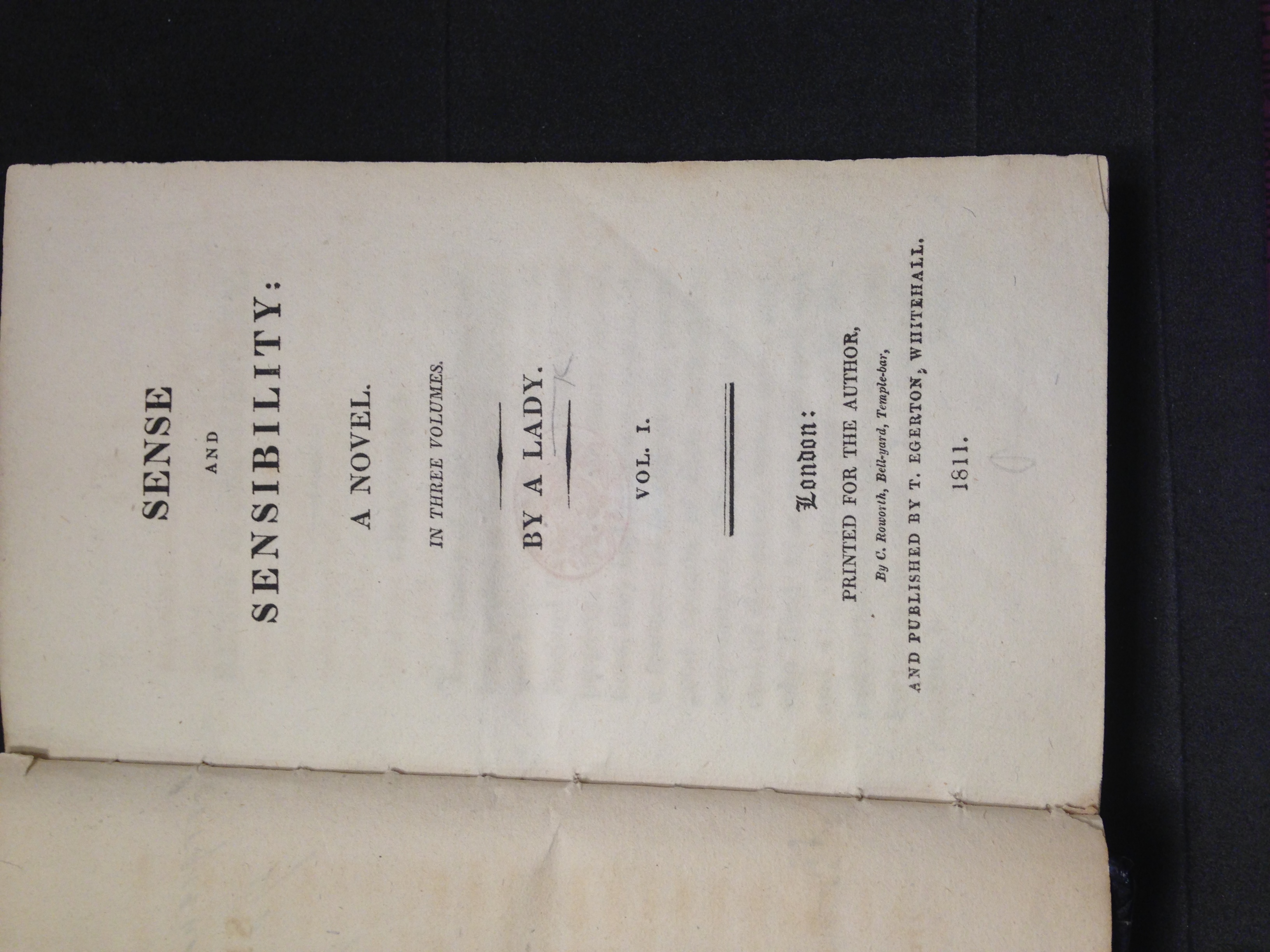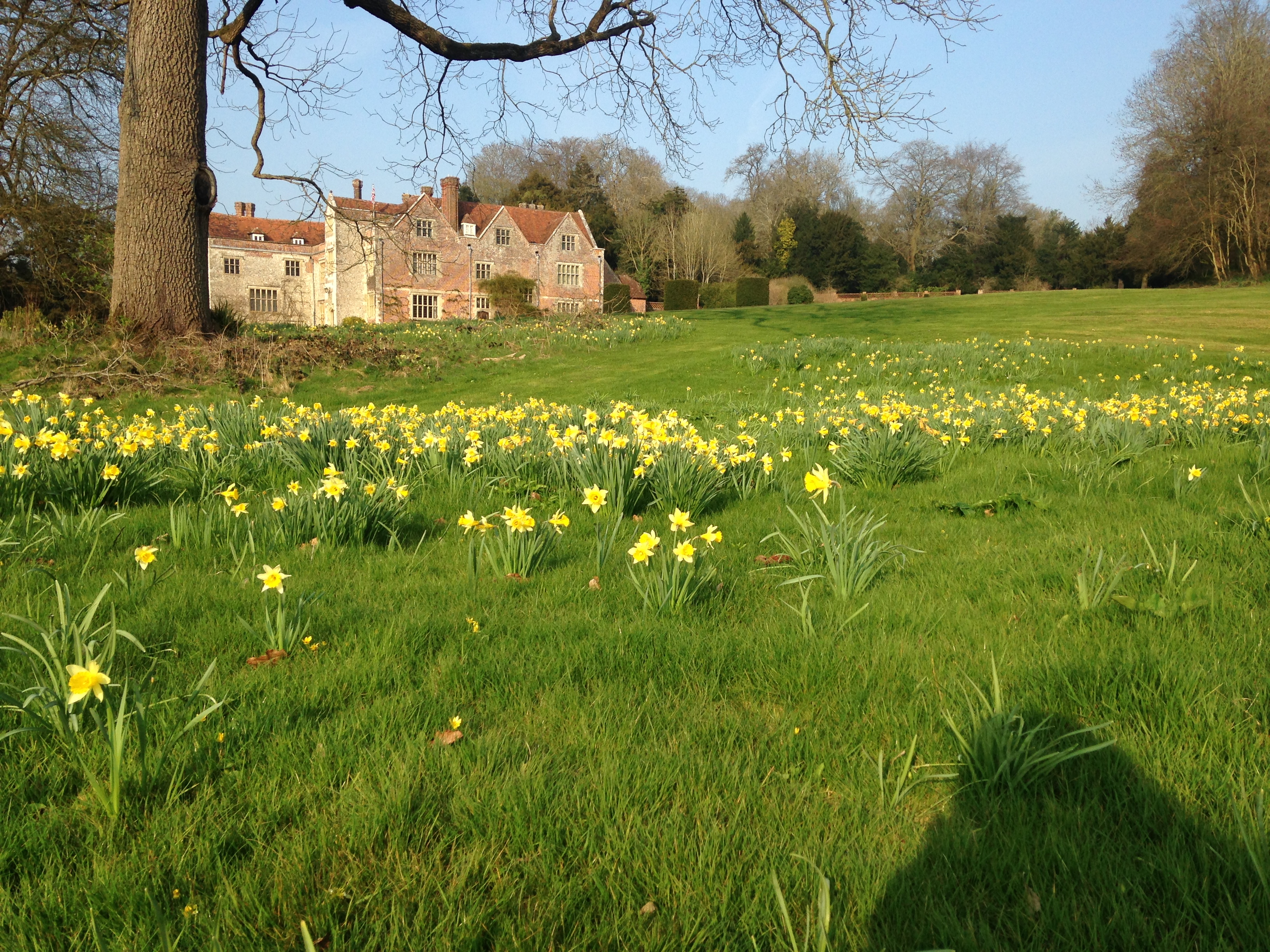
Title page of Jane Austen's first edition of Sense and Sensibility, published by Thomas Egerton in 1811. Photo by Kandice Sharren.
You can listen to Episode 1 of The WPHP Monthly Mercury, "Jane Austen Adjacent", on Apple, Spotify, Stitcher, Google Podcasts, and other podcast apps, available via Buzzsprout.
In this first episode of The WPHP Monthly Mercury, “Jane Austen Adjacent”, hosts Kandice Sharren and Kate Moffatt explore Jane Austen’s publication history, from unpublished anonymity to well-beloved and canonical, to introduce you to The Women’s Print History Project. They share the project’s not-so-humble data collection beginnings at Chawton House Library and the types of bibliographic data collected on the database, and explain the role that bibliographic and publication data can play in understanding the eighteenth- and nineteenth-century book trades. They delve into the networked system of the WPHP: its data model creates links between authors and the firms they worked with, and these links allow us to find obscure women authors by way of looking at the publishing history of other, more exceptional women. The publishing networks of canonical authors point towards numerous, more obscure women authors, and the fascinating potential of their stories outside of the limelight. With an enlightening and gothic glimpse at one publisher’s titles—including a “sepulchral harmonist,” a “mysterious count,” and at least “three monks” (!!!)—as well as an exploration of publishing networks that results in the obscure authors Maryanne McMullan, Charlotte Richardson, and Emma Parker being linked to the famed Jane Austen, Episode 1: “Jane Austen Adjacent” offers an intriguing look at the current work and analytical potential of The Women’s Print History Project.
Credits
Produced by: Kandice Sharren, Kate Moffatt, and Michelle Levy
Mixed and mastered by: Alexander Kennard
Music by: Joseph Haydn, “Concerto in C”, arranged by John Andrewes, and played by Kandice Sharren
WPHP Records Referenced
Austen, Jane (person, author)
Thomas Cadell and William Davies (firm, publishers)
Benjamin Crosby and Co. (firm, publishers)
Emma; or The Foundling of the Wood (title)
The Mysterious Count; or, Montville Castle (title)
Aurora, or, The Mysterious Beauty (title)
Frederick Montravers; or, The Adopted Son (title)
Lindorf and Caroline; or, The Danger of Credulity (title)
Moss Cliff Abbey; or, The Sepulchral Harmonist (title)
Right and Wrong; or, The Kinsmen of Naples (title)
The History of Perourou (title)
The Three Monks!!! (title)
Sense and Sensibility (title)
Thomas Egerton (firm, publisher)
Pride and Prejudice (title)
McMullan, Maryanne (person, author)
The Crescent, a National Poem [...] by Mrs. McMullan, relict of W. McMullan (title)
Parker, Emma (person, author)
Richardson, Charlotte (person, author)
John Murray II (firm, publisher)
Emma (title)
Mansfield Park (title, second edition)
Charles Roworth (firm, printer)
Northanger Abbey and Persuasion (title)
Richard Bentley (firm, publisher)
Porter, Jane (person, author)
Frankenstein (title)
Pride and Prejudice (title, Standard Novels edition)
Sense and Sensibility (title, Standard Novels edition)
Mansfield Park (title, Standard Novels edition)
Emma (title, Standard Novels edition)
Northanger Abbey (title, Standard Novels edition)
Further Reading
Austen, Jane. Jane Austen’s Letters, edited by Deirdre Le Faye, 3rd ed., Oxford UP, 2014.
Clery, E. J. Jane Austen: The Banker’s Sister. Biteback Publishing, 2017.
Copeland, Edward. Women Writing about Money: Women’s Fiction in England, 1790–1820. Cambridge UP, 1995.
Corley, Tony. “Jane Austen and John Murray: Response to a Lecture by Kathryn Sutherland.” Jane Austen Society Report for 2012, 2013, pp. 46–49.
Garside, Peter. “The English Novel in the Romantic Era: Consolidation and Dispersal.” The English Novel, 1770–1829: A Bibliographical Survey of Prose Fiction Published in the British Isles, edited by Peter Garside et al., vol. 2, Oxford UP, 2000.
Gilson, David. “Henry Austen, Banker.” Jane Austen Society Report for 2006, 2007, pp. 43–46.
Halsey, Katie. Jane Austen and Her Readers, 1786–1945. Anthem, 2012.
Levy, Michelle, and Reese Irwin. “The Female Authors of Cadell and Davies.” Women’s Literary Networks and Romanticism: “A Tribe of Authoresses,” edited by Andrew O. Winckles and Angela Rehbein, Liverpool UP, 2017, pp. 99–136.
Mandal, Anthony. Jane Austen and the Popular Novel. Palgrave Macmillan UK, 2007.
Neiman, Elizabeth A. Minerva’s Gothics: The Politics and Poetics of Romantic Exchange, 1780–1820. U of Wales P, 2019.
Raven, James. “The Novel Comes of Age.” The English Novel, 1770–1829: A Bibliographical Survey of Prose Fiction Published in the British Isles, edited by Peter Garside et al., vol. 1, Oxford UP, 2000.
Sutherland, Kathryn. “Jane Austen’s Dealings with John Murray and His Firm.” The Review of English Studies, vol. 64, no. 263, 2013, pp. 105–26.
Viveash, Chris. “Jane Austen’s Early Adventures in Publishing.” Jane Austen Society Collected Reports, 1996–2000, 2001, pp. 78–83.
Special thanks to Chawton House Library for their accommodating staff and extremely useful collection of women’s writing. Chawton House is currently running a fundraising campaign to support them through COVID-19; you can find more information about the emergency appeal here.
 Chawton House and its grounds. Photo by Kandice Sharren (2015).
Chawton House and its grounds. Photo by Kandice Sharren (2015).
This podcast draws on research supported by the Social Sciences and Humanities Research Council.
![]()